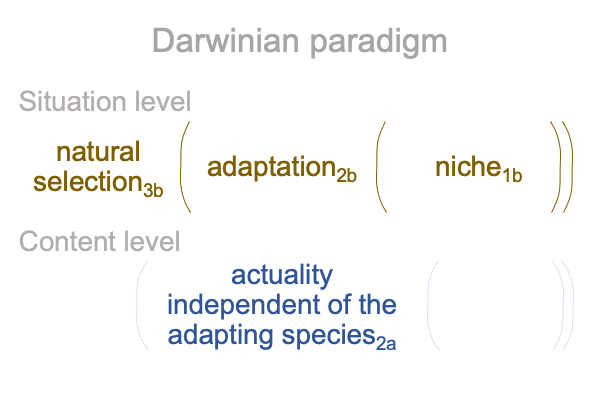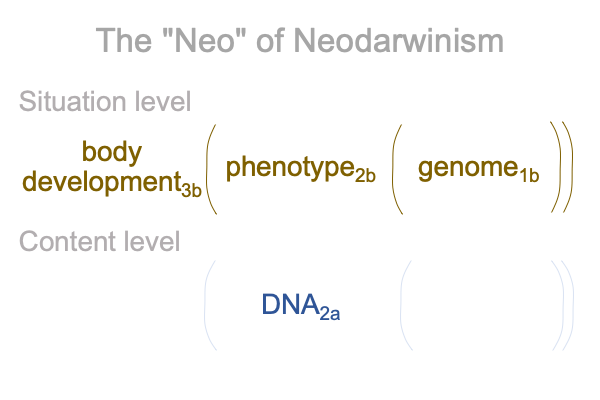0013 Chapter one of Heying and Weinstein’s book is titled “The Human Niche”.
The hypothesis that the ultimate human niche1b is the potential1b of triadic relations2a accounts for the authors’ claim that humans adapt to “switching” among proximate niches. A proximate niche roughly corresponds to an ecology or an environment. The switch entails finding opportunities through understanding. Understanding is the act of adding a normal context3a and potential1a to an independent actuality2a. Understanding is an adaptation2b to the potential1b of triadic relations2a.
0014 Say what?
The ultimate human niche (of the potential of triadic relations) allows humans to rapidly “switch” from one proximate niche (defined as an ecology or an environment) to another.
In Darwin’s paradigm, a niche is the potential that underlies an adaptation. For most species, one finds that a creature’s adaptation solves problems (or finds opportunities) in the so-called “environment of evolutionary adaptation”. By labeling the niche as “the environment of evolutionary adaptation”, modern biologists put on cognitive blinders. “The environment of evolutionary adaptation” implies material beings, not relational beings.
Material conditions goes with proximate niches.
Relational conditions goes with ultimate niches.
The label “environment of evolutionary adaptation” fixes the gaze of modern biologists onto proximate niches.
No modern biologist has come up with a simpler or a more productive hypothesis of an ultimate niche for the Homogenus that the one proposed in Razie Mah’s e-book, The Human Niche.
0015 Once evolutionary biologists (and psychologists) come to terms with the proposition that the ultimate human nicheis the potential of triadic relations (which are purely immaterial beings), they will come face to face with the mystery of human (and all biological) evolution.
0016 Say what?
Mystery of evolution?
At this juncture, I recapitulate a portrait developed in Razie Mah’s masterwork, How To Define the Word “Religion”. The presence underlying the word, “religion”, corresponds to a particular arrangement of category-based nested forms.
Already, the reader of this blog has encountered the two-level interscope. There is another way to combine two category-based nested forms. The intersection is already applied to evolution in Comments on Dennis Venema and Scot McKnight’s Book (2017) Adam and the Genome, along with other commentaries in the series, A Course on Evolution and Thomism, by Razie Mah, available at smashwords and other e-book venues.
So, for me, this is familiar territory.
0017 Here is the two-level interscope for Darwinian evolution.

0018 This figure is only half the picture of modern evolutionary biology.
Contemporary biologists are more than mere Darwinists. They call themselves, “NeoDarwinists”. The “Neo-” of NeoDarwinism points to genetics. Each lineage carries DNA, which is foundationally distinct from the actuality that is independent of the adapting species2a. I could say that DNA is foundationally dependent on the actuality2a of the species. But, DNA is not responsible for the adaptations of the species, even when it serves as an internal foundation to the lineage. DNA is responsible for the phenotypes of the species.
In other words, in the normal context of body development3b, the phenotype2b emerges from (and situates) the genome1b. Plus, the situation-level genome1b is the potential1b of the species’ DNA2a. DNA2a is an actuality on the content level.
The following figure is the other half of the picture of modern evolutionary biology.

0019 What about epigenetics?
Ah, epigenetics (as it is currently formulated) has the same character as niche construction. Epigenetics alters the expression of DNA2a by altering its normal context3a and potential1a.
0020 The authors are natural historians, rather than geneticists. Natural selection comes to the fore in their book. Nevertheless they pay tribute to genetics with a concept, called “the omega principle”, where culture is an adaptation and culture evolves to serve our genes (that is, our lineage). This principle is confusing, because it confounds adaptation2band phenotype2b in a world where biology has specialized into natural historians and geneticists.
I ask, “Is there another way to formulate the mysterious omega principle”?
